|
|
 |
|
|
 |
 |
 |
|
SIMCOX DENIED ACCESS TO PRESS CONFERENCE
by Bill Hess
HERALD/REVIEW
DOUGLAS – While members of different Arizona media outlets were inside the gates of the U.S. Border Patrol’s Douglas Station, a newspaper owner, editor and reporter was denied access to a press conference with Homeland Security Secretary Michael Chertoff.
Chris Simcox, who owns, edits, and writes for the Tombstone Tumbleweed, said he was told Border Patrol Tucson Sector Chief Michael Nicley said he could not attend the press conference Thursday.
Calls for comments from the Tucson Sector public affairs office were not returned.
Simcox said he was told to call Nicley for the reason he was denied access, but the chief had not returned his calls on Thursday afternoon.
“I showed up with credentials and was held outside the gate,” Simcox said, adding it was then he learned from a Border Patrol agent that Nicley refused him access to the press conference.
Simcox is considering seeking advice from an attorney and even the American Civil Liberties Union because he believes his First Amendment rights as a member of the press were denied.
Before the press conference, he received notice of it like other members of the media. Simcox said he sent a letter to the Department of Homeland Security saying he was going to attend. No one from the department’s public affairs office called saying he would be barred, he added.
Simcox said he believes Nicley refused him admittance because of his connection with the Minuteman Project, which involved volunteers watching the border in Cochise County throughout April. Simcox was co-organizer of the event with Californian Jim Gilchrist.
The Border Patrol felt the project was unnecessary.
If he was banned because of the Minuteman Project connection, Simcox said that is unfair because he had a right to attend the press conference and report on Chertoff’s visit.
|
 |
|
|
|
 |
 |
|
MINUTEMAN CIVIL DEFENSE EXPANDS SOUTH AND NORTH; DHS’ CHERTOFF TO VISIT COCHISE COUNTY
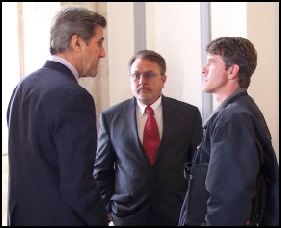
Democratic Senator John Kerry lauded the success of the Minuteman Project during a meeting with co-organizer Chris Simcox in Washington D.C. John Clark (center) of A.I.C. listens while Simcox and Kerry discuss how not enough is being done to secure America’s borders.

Minuteman co-organizers Chris Simcox and Jim Gilchrist wait to address the media with members of congress last week.

Chris Simcox joins guest host J.D. Hayworth at D.C’s Heritage Foundation studio for the Laura Ingram Show.

A Latina protester sends President Bush a clear message in Washington D.C.
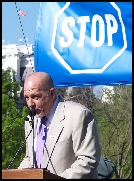
Founder of the American resistance D.A. King addresses crowd in front of the White House during “Hold Their Feet to the Fire” rally.
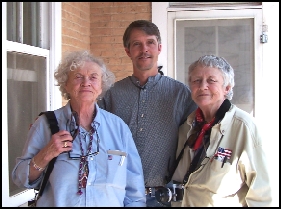 
“Vigil Annies” Dayna and Helen from California stop by the Tumbleweed to say thanks for a once in a lifetime experience. The two were part of the Minuteman Project that helped shut down the Naco sector human and drug smuggling routes.
On the right, Jim Gilchrist says job well done at the final day ceremonies in Palominas.

Minuteman sector supervisor Mike Gaddy was instrumental in organizing volunteers
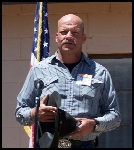
Bob Wright from new Mexico proved to be a key leader during the month-long project.
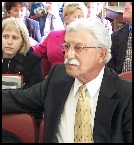
Al Garza spoke on behalf of American-Hispanics.
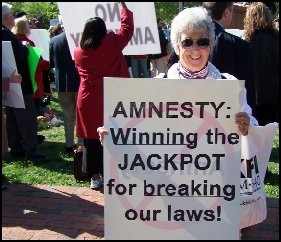
Elaine from California holds up her protest sign in front of the White House during “Hold their Feet to the Fire” rally.
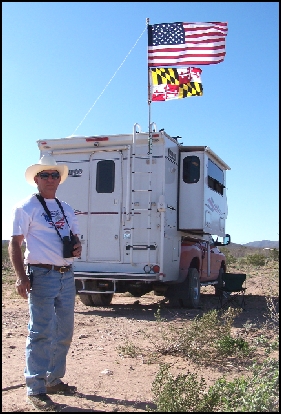
Minuteman Naco line shift supervisor Ed W. from Maryland keeps a close eye on activity south of the border.
By Rick Murray and
Chris Simcox
“It’s not over,” declared Chris Simcox, co-organizer of the Minuteman Project. This statement was issued to the press as the closing ceremonies for phase one of the overwhelmingly successful project that has succeeded in sparking a national debate on how better to secure the borders with Mexico and now Canada.
With the promise of over 20,000 volunteers to man posts in several states on both borders for the next phase, it is quite likely that the project is just beginning. Such were the sentiments of the volunteers who attended the event that was also covered by several national news networks.
“I have all the confidence in the world that Jim and Chris will keep this going and that you folks, with your friends and your neighbors, will get this done around the country and prove that this can be accomplished.” These words of encouragement by State Representative Randy Graf were met with a loud chorus of cheers and applause. Many of the members who were part of the month long message to the government, echoed the sentiment and promised they would never give up. Many have already signed up to continue the volunteer effort.
Jim Gilchrist and Chris Simcox returned last week from a three day trip to Washington, D.C., where they joined a lobbying effort - “Hold Their Feet To The Fire” - organized by San Diego talk show host Roger Hedgecock. Hedgecock was joined by 17 other national talk show hosts who broadcast live from the D.C. Holiday Inn “radio row”. Dozens of congressmen and a handful of senators visited during the week making guest appearances on the shows, all of which addressed border security and the problems associated with unchecked illegal immigration into the United States.
Joining the effort were almost 500 citizen lobbyists who marched the halls of Capitol Hill and visited the offices of almost every congressman and senator. Simcox said it was important to work both sides of the aisle as border security should not become a partisan issue.
“This has nothing to do with liberal or conservative agendas. I consider myself a pragmatic independent and the issue of open borders is a clear and present danger when it comes to national security,” said Simcox.
Over and over, spokespeople for the Minuteman Project stepped up to the microphone to thank the members for their participation. Each offering added more to the list of accomplishments the group achieved.
Organizers reported that 876 People participated in the 4 hour Training Session and volunteered for at least one 8-hour shift on the line. 63 people volunteered for the entire Project. The average time on the line was 4.87 days (when the 63 were not included in the stats). Another 14 volunteers assisted with administrative task at the offices of the Tombstone Tumbleweed.
61 people volunteered for communications and security at the Miracle Valley Bible College.
At least 349 illegals were detained by the Border Patrol as a result of MMP volunteers observing, reporting and directing agents to locations. Many more were spotted but it could not be confirmed that Border Patrol apprehended subjects illegally in the United States.
187 Minuteman volunteers attended the closing event in Palominas.
Numbers released by the Border Patrol showed that compared to last April’s figures, the Minutemen presence appears to have prevented some 60,000 potential illegal aliens from crossing along the Naco corridor. Illegal alien crossings as well as drug smuggling were essentially stopped along the Naco corridor during the month of April.
Jerry Seper of the Washington Times reported this statistic: “In April 2004, Border Patrol agents caught 64,000 illegal immigrants along the stretch of border targeted by the Minuteman volunteers — more than 2,100 a day. Last month’s total, as a result of the Minuteman vigil, is expected to be fewer then 5,000.”
A moving testimony was offered by Ken Davis, who was credited for stopping a small group of illegals smuggling 40 pounds of marijuana when he and his wife, while on patrol, spotted some birds being flushed from the lowland brush.
Mr. Davis related a story of a border patrol agent who had stopped to have coffee with him at his station. The agent wanted to offer his feelings of gratitude to the Minutemen. The agent related the development of support from the Border Patrol going from thinking the Minutemen were a, “Bunch of hillbillies out there drinking and waving guns, but after the third day we knew that’s not what it was.” The agent told of a “pool” they had started to bet on when the Minutemen would leave. Most bet somewhere in the first two weeks.
Not only did the Minutemen last the entire month as scheduled but they are expanding to at least six more states starting in October to include at least three on the Canadian border. “I go to Michigan in two weeks; already the people in Michigan cannot wait to get this started on the northern border,” said Simcox.
The Minutemen have inspired several groups to organize with the same goals. A southern California group, The Friends of the Border Patrol, a group formed last year to support the Border Patrol, is developing a group of volunteers, the “FBP Border Watch,” currently consisting of about 300 retired police officers, military personnel, pilots and other citizens who have offered their services. Led by Chairman Andy Ramirez, they hope to expand from the Pacific Ocean to the Arizona state line.
Commenting on the rise of the clone groups, Simcox said, “We see that there are already other groups that are forming; we hope that they allow us to share our success with them and that we can all work together and grow this movement.”
Minuteman co-founder James T. Gilchrist, a retired California certified public accountant and combat-wounded Vietnam veteran, endorsed the California effort, offering his support and advice — including the need for law enforcement and military personnel to participate to help “weed people out who do not belong.”
But a warning was offered by Gilchrist and echoed by Representative Graf. Commenting on the trip to Washington, D.C., by both Simcox and Gilchrist he said,” But we didn’t come back here without a warning. And we got the attention of Congress, state and federal levels, but the warning is, if we stop after this 30 days it’s just going to be viewed as a month long dog-and-pony show and the interest in Congress will fade literally overnight.”
Graf agreed saying, “Jim was right: it can’t end today. If it does, this goes under the radar.” This is a critical point in homeland security. A strong message was sent to the government with the apparent success of the project, but some are still under the belief that it was a, “Flash in the pan,” effort. The only way to ensure the message is clear is to continue the efforts along both borders.
Probably an equal or greater testimony is offered by the residents though. Many are hopeful about the future of the area enforcement of the border problems as a result of the success of the Minuteman Project, though they lament the departure of the participants, many of whom have become like family to the residents.
Resident Connie Faust emotionally stated, “You have no idea how much safety and quiet you have given us, how grateful we are that you all are here.”
Congressman J.D. Hayworth, (R-Az), said in a statement, “We have a group of concerned citizens who intend to keep the effort going. That’s what they are. Concerned citizens, a neighborhood watch, not a bunch of vigilantes.”
|
 |
|
|
|
 |
 |
|
PROTECTING BORDERS IS A VITAL FIRST STEP TO FIX IMMIGRATION
In response to the problem of illegal immigration, some Arizona residents have taken action on their own.
An organization called the Minuteman Project uses unarmed civilian volunteers to patrol the U.S.-Mexico border along a 23-mile stretch in Arizona. They alert authorities when they spot illegal activity, and claim their work has led to hundreds of migrants being rounded up before they could enter the country.
Law enforcement authorities and federal officials are concerned that the Minuteman movement could lead to violent confrontations between border smugglers and civilian spotters. That hasn’t happened yet, but it is a valid concern.
The bigger picture, though, is what motivates these folks to spend time patrolling the desert. They claim that their work would not be needed if the U.S. government did a better job of securing the border.
They have a point. For years, those on all sides of the immigration debate have supported increased border control by the government. The flood of illegal immigrations has many causes, economic and social, which are difficult to control. But better enforcement of our borders is within our grasp and would be an important first step toward a more effective immigration policy.
Here in Hall County, the number of illegal immigrants from Latin America is estimated to be in the tens of thousands. Most cross the border to fill jobs in manufacturing and low-salaried positions that economic experts say Americans no longer want. As long as there is work, the lure remains strong.
The problem of illegal immigration has not been addressed effectively by the federal government. President Bush has advocated reform, such as granting guest worker status, but Congressional leaders seem cool to his ideas and the administration has not aggressively pushed them.
Lawmakers are torn between interests on competing sides of the debate: those who want to stem the tide of undocumented residents against business interests who profit from low-salaried workers.
It is in everyone’s best interest that a more workable immigration policy be enacted. The U.S. government could fill the economic need for such workers by increasing the number of legal immigrants from friendly nations and make the process of granting legal work status more accessible to those who seek it.
It is in our best interest to see that those who seek to work here do so with proper documentation. By creating a document trail, the government can weed out potential criminals. Legal immigrants can get driver licenses and car insurance. And law enforcement officials can better keep tabs of those who are documented.
But in the process, our nation must also work harder to protect its borders from those who cross not just to work for their families, but to do us harm. In the age of international terrorism, it is crucial that we do more to keep those with criminal intent out of our country.
Rep. Nathan Deal has been an outspoken advocate of border control. At a recent party convention, he urged the White House and his party’s national leadership to address the strain illegal immigration puts on our national security and social services.
Even many who favor a looser immigration policy agree. Those who cross the border illegally face great danger. Unscrupulous black-market smugglers exact a king’s ransom from poor migrant workers in return for safe passage to the United States.
In the worst cases, those transits can end in death, as in the case of 19 immigrants who suffocated while being transported by truck in 2003 in south Texas. Many others are known to drown in the Rio Grande River or die in the desert heat.
Better border control would put the black market out of business and keep terrorists out of the country. Those who come here legally to work and share in the American dream should not have to work alongside those who have not made that effort.
The hope here is that Congress and the White House will work harder to address the immigration issue, starting with stronger border control. That would signal the nation’s desire to address the problem effectively, and help make such groups as the Minuteman Project unnecessary.
|
 |
|
|
|
 |
 |
|
GRAF TO AGAIN CHALLENGE KOLBE
By Rick Murray
Sierra Vista, Az. “I am not against immigration,” stated State Representative Randy Graf in an interview before a scheduled press conference where he officially announced his candidacy to unseat incumbent Congressman Jim Kolbe, (R-Az) in Arizona’s eighth congressional district.
“The problem is not legal immigration but illegal immigration.” Graf made his position clear as he discussed the issue during an interview.
This is Graf’s second attempt to unseat Kolbe who has served in the House for 11 terms. In the 2004 election Graf lost in the republican primaries but carried Cochise County where illegal immigration is a hot-button issue.
Relating the issue of illegal immigration with another hotly contested issue, the guest worker proposals, Graf pointed out that he does not believe the answer to illegal immigration lies in a guest worker program. He believes that such a program would actually make the situation worse as these types of bills tend to serve as an open invitation to more illegal immigration.
“We already have enough laws on the books right now that allow immigrant workers to come into this country. The problem is that they are not properly executed or enforced. The McCain, Kolbe, Flake plan only creates two more visa programs. There are more visa plans than there are immigrant workers,” Graf said. “You need a visa to come as a student, an athlete, a worker. There are visitor’s visas, dozens of work visas... so many I can’t even describe them all!”
Kolbe co-sponsored a guest worker bill along with Sn. John McCain, (R-Az), and Jeff Flake, (R-Az) that would add two more visa programs though specifics of the visas are not clear. However, there is specific language in the bill, H.R. 1320, (section 142,) that specifically allows for immigrant workers to obtain commercial drivers licenses. In an interview with Congressman Kolbe last year he specifically stated that under no circumstances would he allow for immigrant workers to obtain American commercial drivers licenses.
Commenting on news reports that Bill Gates cannot find enough employees to fill technical vacancies, Graf said, “We already have high tech visas to allow immigrants to come into this country to work for firms like Microsoft. This is on a lottery basis so the numbers of immigrants for those jobs are limited specifically so American workers would have first shot at the jobs. But, is it that Mr. Gates cannot find enough qualified workers or that he cannot find enough that are willing to do the job for what he is willing to pay.”
Graf stated that immigrant workers from such countries as Pakistan and India take these jobs for $40-50,000/year while comparable salaries for Americans in the same position range from $60-80,000/year. “We have tens of thousand’s of displaced tech workers already that are more than willing to take these jobs but cannot get hired due to salary requirements. Gates and others should be looking for American workers before going overseas.”
Students taking up computer science programs in college are down because the job market for American workers in this field are presently limited.
“There are workers for all trades in this country already with education, training and skills and a willingness to work but there are too many industries that are looking for cheaper labor in the guest worker programs. Currant language in guest worker proposals do not protect American jobs.”
Most guest worker proposals simply state that a company must advertise an open position for a minimum of two weeks to prove they cannot find a qualified American worker. If the position is not filled then a guest worker may be hired.
“One can certainly see where this debate is headed. Whether it is on the high tech end or the lower end of the labor market, the currant path will just drive down overall wages,” said Graf
|
 |
|
|
|
 |
 |
|
FROM A NEWLY SWORN CITIZEN OF THE UNITED STATES OF AMERICA
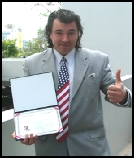
Friday 29th April 2005 Los Angeles Ca, United States of America—My dear fellows Americans today I’ve achieved the dream of my life...I am officially an American Citizen! Technically I was born in Rome Italy, my accent and my English is not exactly what you can call perfect, and yes, I love pasta, but in my heart, in my blood and in my spirit I’ve always felt as an American... It took me almost 7 years since I came legally to this Country to become an American citizen... following the rules and the laws of the Land! Today America is officially my Country, the Country that gave me the opportunity to become a better man, the Country that gave me the opportunity to realize my dreams, the Country that gave me the opportunity to feel home and to create my own family...I made an official oath during the ceremony of my Citizenship, the oath to defend America against all enemies, foreign and domestic...And I am here to renew my oath, to defend America and its Constitution even with my life if necessary... and I add to my oath, that I am ready and willing to join and defend all the American people that love this Country and they are fighting this historical struggle against the Illegal Immigration and this silent invasion.
So, my dear Illegal invaders that come to America with the object to conquer, divide and suck our Tax Dollars, Dear corrupted politicians on the payroll of Foreign Countries like Mexico, Dear Racist organizations with reconquista’s dreams like la Raza, dear Communists and Trojan horses on America soil that are trying to destroy our Constitution, creeds and our way of life like the ACLU...Today you have a new enemy...and that’s me.
From now on, I am not an Italian, not an immigrant, not an Italian-American, not an American-Italian; I am just a proud American who is ready to die for his Country and for his fellows Americans.
Gianluca Zanna
I hereby declare, on oath, that I absolutely and entirely renounce and abjure all allegiance and fidelity to any foreign prince, potentate, state or sovereignty, of whom or which I have heretofore been a subject or citizen; that I will support and defend the Constitution and laws of the United States of America against all enemies, foreign and domestic...so help me God.”
|
 |
|
|
|
 |
 |
|
IMMIGRANT PLEAS CRUSHING FEDERAL APPELLATE COURTS
As caseloads skyrocket, judges blame the work done by the Board of Immigration Appeals.
By Solomon Moore and Ann M. Simmons
Immigrants fighting to stay in the United States are flooding the federal appellate courts with cases, creating huge backlogs and fundamentally changing the character of the second-highest courts in the nation.
The deluge reflects growing dissatisfaction with the nation’s immigration courts, and attorneys representing asylum-seekers and others say they have little choice but to appeal to the federal judiciary.
The trend is nationwide, federal records show, but bearing the brunt of this sudden surge is the San Francisco-based U.S. 9th Circuit Court of Appeals. In the year ending June 30, 2001, the immigration caseload was 965. It skyrocketed to 4,835 cases in the year ending in June 2004.
“Three years ago, immigration cases were 8% of our calendar,” said 9th Circuit Judge Michael Daly Hawkins. “Today, as we speak, that percentage is 48%.”
The 9th Circuit is the nation’s largest federal appellate court and has long had a liberal reputation, but its immigration caseload is largely driven by the region it serves: California, eight other states and two territories. The court’s 24 judges consider myriad cases that must now compete with the ever-growing immigration backlog.
“There are only so many judges available to hear and decide cases,” said 9th Circuit clerk Cathy Catterson, adding that appellate cases used to take about six months to complete; now they can take about nine months.
“We feel overloaded by this problem,” said Dorothy Nelson, another 9th Circuit judge. “It’s just extraordinary. I’ve been on the court for 25 years, but I’ve never seen a rush … overwhelming us like this. Frankly, the immigration system needs to be reformed.”
The cases inundating the circuit courts are coming from the Board of Immigration Appeals, a quasi-judicial body appointed by the U.S. attorney general.
The mounting workload has prompted federal judges to criticize the BIA’s work in uncharacteristically blunt terms.
“The BIA’s decision was nonsensical,” a 9th Circuit panel wrote in March of an asylum case. “Not only was the BIA’s opinion an example of sloppy adjudication, it contravened considerable precedent.”
Many people caught entering the country illegally never appear in the nation’s 53 immigration courts, which primarily deal with those hoping to obtain asylum or avoid deportation.
In those courts asylum-seekers testify about persecution they suffered in their home countries, hoping a judge will allow them to stay here. Other immigrants fight to remain in the United States after a criminal conviction makes them eligible for possible deportation.
Still others petition immigration courts to change their residency status from temporary to permanent. Petitioners who disagree with an immigration judge’s ruling may appeal to the Virginia-based BIA.
The sharp rise in BIA decisions being appealed to the circuit courts has been triggered by several factors:
• Overall immigration is up, increasing the pool of potential petitioners. According to an analysis of census figures by the Washington-based Center for Immigration Studies, the immigrant population, both legal and illegal, reached more than 34 million in March 2004 — an increase of 4.3 million just since 2000.
• Tougher enforcement of immigration laws has also funneled more cases into the system.
• The BIA’s duties were curtailed and its size halved, from 23 to 11 members, as a cost-saving measure in 2002.
The caseload now clogging the federal courts was, in large part, an unintended consequence of attempts to ease a backlog at the BIA, which had 57,200 cases pending in 2002.
That year, then-Atty. Gen. John Ashcroft issued policies intended to clear the logjam, saying the backlog “gravely undermines the enforcement of our country’s immigration laws.”
To speed up the process for certain cases, Ashcroft directed the BIA to either approve cases or send them back to immigration courts outright. In the past, the BIA often researched and wrote new opinions.
This “streamlined approach” was designed to expedite matters for aliens entitled to stay in the country, said officials at the Executive Office of Immigration Review, a unit of the Department of Justice.
The officials, who responded to questions in writing, added that the reforms also hastened the deportation of illegal immigrants, “some of whom posed a threat to our nation.”
In the wake of Ashcroft’s reforms, the BIA increasingly issued one-sentence rulings endorsing or remanding immigration judges’ decisions. These “affirmances without opinion” made up 6% of the board’s decisions in 2001 and a third of all decisions three years later.
At the BIA, the reforms are indeed speeding up the disposition of cases, but the faster pace has been accompanied by more decisions siding with the government, records show. Five years ago, the BIA ruled in favor of immigrant appeals 9% of the time. By 2003, immigrants won their appeals 6% of the time.
Critics say the BIA reforms have hobbled the agency and eroded an important level of review for immigration cases.
“Why even have a BIA? You might as well go from the judge to the [circuit] court and save the person the money of having to go to the BIA,” said Los Angeles immigration lawyer Carl Shusterman.
One statistic sums up the growing dissatisfaction with the BIA. Before the reforms, about 5% of board decisions were appealed to circuit courts, according to immigration officials. Now 25% reach the federal courts.
Raul Godinez, chairman of the Southern California chapter of the American Immigration Lawyers Assn., echoed that view. “Individuals want to know that they’ve had their day in court, and they want to make sure they’ve been understood,” he said.
Some immigration attorneys acknowledged that the generally liberal reputation of the 9th Circuit and its willingness to challenge rulings by immigration judges and the BIA often influenced their decision to appeal to the court.
But more important are a case’s merits, a client’s willingness to continue a legal fight and the 9th Circuit’s expertise, said Edward W. Pilot, a Beverly Hills-based immigration lawyer.
“I have much more confidence in the wisdom and decision-making process of the 9th Circuit justices than I do in the Board of Immigration Appeals judges,” Pilot said.
Jurists, legal scholars and immigration lawyers interviewed argued that the BIA reforms have come at the expense of the nation’s circuit courts.
The Executive Office of Immigration Review acknowledged that view:
“Some have argued that the Board’s use of affirmances without opinion is the cause of the increase in the rate of appeal, because aliens are not satisfied with those decisions and feel they have been given short shrift in the administrative review process,” wrote agency officials.
Recently appointed Atty. Gen. Alberto R. Gonzales acknowledged that immigration cases were beginning to bog down the federal judiciary. In a speech before Stanford University’s Hoover Institution in March, he said federal courts were “straining under the weight of an immigration litigation system that is broken.”
Gonzales urged Congress to propose legislation to address the problem — a remark that prompted a rebuke from Sen. Patrick J. Leahy of Vermont, the ranking Democrat on the Judiciary Committee.
In a written statement, Leahy said the problem was caused by Ashcroft’s “misguided restructuring of the Board of Immigration Appeals.”
One result of the changes, according to circuit court officials, is a new role for the appellate courts. The BIA’s reliance on one-sentence opinions has forced circuit courts to spend more time researching and deliberating the immigration cases that come to them, court officials say.
“The BIA used to set forth reasoning as to why they affirmed the immigration judge,” said Catterson, the 9th Circuit clerk. “Now if they affirm, you often don’t know what the grounds are. Basically, the appeals courts now have to serve in the role of the BIA.”
That practice has laid bare the deficiencies of immigration courts, where overloaded administrative law judges often serve as their own clerks — recording their own hearings, doing their own research and often ruling from the bench.
“Immigration judges have begun to look really bad in the circuit court decisions because the BIA used to review things. We were encouraged to do things in a short-and-dirty manner, knowing that the BIA would return them if we went too far,” said San Francisco-based Immigration Judge Dana Leigh Marks, president of the 220-member immigration judges union.
“Now, the BIA is issuing all of these affirmances without opinion and we have no resources to do a top-notch job from the beginning,” Marks said. “We’re like the guy behind the curtain in ‘The Wizard of Oz,’ for God’s sake.”
Several circuit courts have departed from their usual decorum to blast the BIA for failing to explain decisions or correct mistakes by immigration judges.
A ruling by a 9th Circuit three-judge panel in March had this to say about a BIA ruling involving a man who claimed he fled ethnic persecution in Guatemala: “When the agency’s only explanation of its final action is incoherent, we may not substantively review it without violating basic principles of judicial review.”
At a conference attended by federal appellate judges, BIA members and other immigration law officials last year, Hawkins, of the 9th Circuit, suggested that judges in his court had become so frustrated with the poor quality of many immigration judge decisions that they had considered shaming them into better practice.
“The largest applause line I got the entire time I spoke was when I said our circuit was considering identifying [poor performing] immigration judges by name in our opinions,” Hawkins recalled.
Circuit court and immigration judges interviewed estimated that the appeals courts are now reversing a greater proportion of cases than before the BIA restructuring, although statistics on the issue have not been compiled.
“The conventional wisdom is that the elimination of one level of review has resulted in more remands,” said Mary Schroeder, chief justice of the 9th Circuit.
The BIA, however, is cutting back on its workload.
That 57,200-case backlog faced by the BIA a few years ago was reduced, as of March, to 32,100. It’s a workload the agency views as manageable.
|
 |
|
|
|
 |
 |
|
SLAVERY GROWING PROBLEM IN THE U.S.
Human smugglers are exploiting the increasing numbers of undocumented illegal aliens flooding into the United States because of a lack of border security. Earlier this week Justice Department attorney Lou DeBaca told reporters in Mexico City that prolonged captivity kidnapping is contributing to more than 16,000 cases of slavery in the United States each year.
DeBaca traveled to Mexico City in an effort to increase cooperation with Mexican officials in prosecuting cases of kidnapping and enslaving helpless migrants looking for work in the United States.
Many illegal aliens are enslaved as workers, many of whom are forced into prostitution or as agricultural field hands, a U.S. Justice Department anti-slavery prosecutor stated on Monday, May, 2.
“Safe houses” used by traffickers of human beings are becoming more prevalent in U.S. border states and now on the interior. Illegal workers are held for days and sometimes weeks as smugglers attempt to extort money from family members who are told their relatives will be killed or tortured if they don’t pay a ransom.
|
 |
|
|
|
 |
 |
|
MEXICO BORDER WATCH EXPANDS
By Jerry Seper
An organization of citizens in California, created last year to support the U.S. Border Patrol, will begin its own Minuteman-style vigil in August, using volunteers to spot illegal aliens in areas around San Diego, organizers said yesterday.
The Friends of the Border Patrol, led by Chairman Andy Ramirez, said 300 retired police officers, military personnel, pilots and other citizens have offered their services for the “FBP Border Watch,” which the organization hopes to expand eventually from the Pacific Ocean to the Arizona state line.
The volunteers, Mr. Ramirez said, also include people to patrol the border on horseback and a contractor who has offered to build a base camp for the operation.
“America was built on the spirit of volunteerism and community,” said Mr. Ramirez, who previously headed Save Our State, which helped defeat efforts by California lawmakers to authorize drivers licenses for illegal aliens. “Citizens volunteering to defend our nation in time of war and crisis is a time-honored American tradition.
“The American people are looking for ways to bolster Border Patrol numbers,” he said. “It’s clear they want more agents and secure borders.”
The planned California vigil is patterned after the Minuteman Project, during which more than 800 volunteers manned observation posts on a 23-mile stretch of the Arizona-Mexico border east and west of Naco, shutting down a flood of foreigners in the area — one of the most popular corridors for alien smugglers in the country.
Minuteman founder James T. Gilchrist, a retired California certified public accountant and combat-wounded Vietnam veteran, endorsed the California effort, offering his support and advice — including the need for law enforcement and military personnel to participate to help “weed people out who do not belong.”
Minuteman co-organizer Chris Simcox, a Tombstone, Ariz., newspaper publisher and founder of Arizona’s Civil Homeland Defense Corps., has said that “tens of thousands” of volunteers will be ready in October to control illegal immigration along the U.S.-Mexico border from California to Texas.
“We will package up what we’ve done here and do it again as a multistate border project. We will tell the government to do its job in securing this border or we will shut it down ourselves,” he said.
Mr. Simcox also said this past week that the Minutemen are looking to help organize patrol efforts in four states along the U.S.-Canada border — Idaho, Michigan, North Dakota and Vermont.
“We shouldn’t have to be doing this,” he said Tuesday. “But at this point, we will continue to grow this operation — also to the northern border.”
Mr. Ramirez said a well-organized and planned operation around San Diego was essential “to ensure the safety of everyone involved, from Border Patrol agents, the volunteers, illegal aliens and even those counterprotesters seeking to disrupt the Border Watch.
“We have asked everyone that they participate with but one intention — to behave in a professional manner and follow the rule of law,” he said.
Advising the California volunteers will be Joseph N. Dassaro, former vice president of the National Border Patrol Council, which represents all 11,000 nonsupervisory Border Patrol field agents.
Mr. Dassaro, a 13-year Border Patrol agent and head of the council’s Local 1613 in San Diego, quit the agency last week, saying a failed bureaucracy and lack of support from Congress and the Bush administration made it impossible for rank-and-file agents to secure the borders.
In a letter to Local 1613 members, Mr. Dassaro called the Border Patrol “one of the most inefficient and misleading agencies in the history of government.”
Officially, the Border Patrol was not supportive of the Minuteman Project, saying immigration enforcement was the responsibility of the federal government. It has cast similar doubts on the California proposal.
Numerous rank-and-file agents in Arizona, however, told The Washington Times they welcomed the volunteers and the nationwide attention their project brought to the problem of the porous southern border.
|
|













